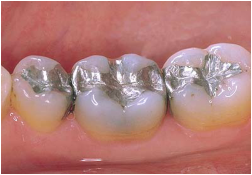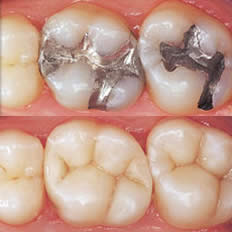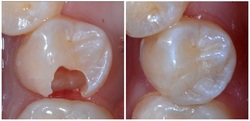Amalgam
What you may call silver or metal fillings and what dentists call amalgam restorations have been around for many years. Many people have lots of these fillings in their mouths and there has been much debate about their safety in the past but despite this lots of these are still placed in the UK. read this article and in particular the conclusion on mercury and other amalgam issues if you are at all concerned.
Amalgam fillings have a good track record with many patients having had them in their mouths for twenty years without need for replacement. They are strong, hardwearing and will not wear away the teeth that they are biting against any more so than your natural teeth would. They are cheaper for the patient not only as the materials are generally less expensive to buy but they generally take less time to place than white (composite) fillings
The disadvantages of amalgam fillings are that they do not add any strength to the tooth they are being used in, they are used to replace the decayed tooth substance so as the tooth decay does not progress. Large amalgam fillings may be difficult for the dentist to carve into the original tooth shape although there are many dentists that can do this very well!
There are a small proportion of patients that will be allergic to one or more of the alloys in the material which if so will usually cause a white patch on the gum or cheek next to the filling. If this happens they should be replaced with a different material
Amalgam fillings do not bond to your teeth, they just fill the space where tooth is missing and so small cavities/holes need to be made so as when amalgam is packed into them it is held in. If this is not possible then sometimes small pins are placed to hold the filling in place but this is not ideal and in these cases a less damaging and more suitable option would probably be a bonded onlay whether it be metal or white (which in the case of an onlay would be porcelain) see onlay page for an explanation
So if you need small to medium sized fillings and you are not bothered about colour then amalgam may be the most cost effective choice, although use your own judgement in each case as well as your own dentists advice.
|
Fees vary greatly depending on the type and size of fillings as well as the experience of the dentist. A composite filling may range from £40 - £250 or more depending on the size; an amalgam from £30 - £150 depending on the size and onlays/crowns/veneers as discussed before from £300 - £1000 or more depending on materials, location and whether you need additional items such as extra models, visits to the lab for shade matching etc. If you have a query about a fee, your dentist will most likely be happy to explain what is involved and why the fee is set at what it is or you can always ask a dentist here. Amalgam restorations will be available from health service dentists at the health service fee and composite restorations may also be available on front teeth on the health service at health service fees. It may be worth asking about a private alternative if you are a health service patient but would like the best or most aesthetic treatment possible
White Fillings
White composite fillings take longer to place than silver fillings as they are generally placed in small increments and then require polishing afterwards. This means a medium sized filling which would take 20 minutes in amalgam may take 45 minutes in white composite filling material and so the fees will reflect this and the increased material cost. Some Dentists are more experienced than others when it comes to placing composite/white fillings and some have a special talent in making them look very realistic even under magnification! Others may not be quite as artistic but all dentists should be able to place an aesthetic white bonded filling which will match the colour and shape of your tooth closely.
The drawback with white fillings is that the area they are placed needs to be completely dry in order for them to stick onto your teeth properly. This is why many dentists will place a big rubber sheet around your tooth called a rubber dam to keep the area dry, others may use cotton wool rolls and suction but if the area cannot be kept dry throughout the entire procedure then this filling will not stick properly and it will not last. This may be why your dentist suggests crowns, onlays or amalgam fillings in very back teeth that they are struggling to keep dry whilst working on.
Now for white fillings/restorations - these bond to your tooth and are white and so can look very realistic. There are very few people allergic to the materials used for these and they should be the go to option for teeth with small to medium sized cavities/holes/fractures. Again these can sometimes be difficult to replicate the shape of the missing tooth they are replacing but really this depends on your dentists experience with the material and what they have found to work best in their hands. for smaller fillings it should generally be white composite filling material but in larger fillings they may suggest a lab made onlay instead if they feel this will be more cost effective for yourselves in the long term and give you a better result.
|



 RSS Feed
RSS Feed